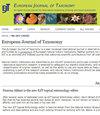Three new species of the genus Leucopholis Dejean, 1833 (Coleoptera, Scarabaeidae, Melolonthinae, Leucopholini) from the Philippines and designation of a neotype for L. semperi Brenske, 1896
IF 1.3
3区 生物学
Q3 ENTOMOLOGY
引用次数: 0
Abstract
Three species of Leucopholis Dejean, 1833 chafers from the Philippines are described and illustrated: Leucopholis stainesi sp. nov., L. bezdeki sp. nov. and L. ratcliffei sp. nov. A neotype is designated for Leucopholis semperi Brenske, 1896. A revised key to the species of Leucopholis in the Philippines is provided.菲律宾Leucopholis Dejean属的三个新种,1833(鞘翅目,Scarabaidae,Melolonshinae,Leucopholini)和L.semperi-Brenske的一个新类型的命名,1896
描述并举例说明了菲律宾产的三种Leucopholis Dejean,1833只金龟子:Leucopholis stainesi sp.nov.,L.bezdeki sp.nov..和L.ratcliffei sp.nov.1996。提供了一个菲律宾Leucopholis物种的修订索引。
本文章由计算机程序翻译,如有差异,请以英文原文为准。
求助全文
约1分钟内获得全文
求助全文
来源期刊

European journal of taxonomy
ZOOLOGY-
CiteScore
2.30
自引率
8.30%
发文量
173
审稿时长
29 weeks
期刊介绍:
EJT is a fully refereed, international, fully electronic Open Access journal in descriptive taxonomy, covering subjects in zoology, entomology, botany (in its broadest sense), and palaeontology. EJT-papers must be original and adhere to high scientific (content) and technical (language, artwork, etc.) standards. Manuscripts that are clearly substandard in either of these categories will not be sent out for review. EJT is supported by a consortium of European Natural History Institutes, but its scope is global. Both authorship and geographical region of study need not be European. Authors are, however, strongly encouraged to involve European Natural History collections by consulting material or by depositing specimens (e.g. types and figured material) related to their published paper in the collection of a European Natural History Institute.
 求助内容:
求助内容: 应助结果提醒方式:
应助结果提醒方式:


